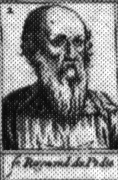
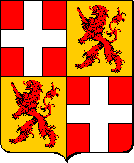
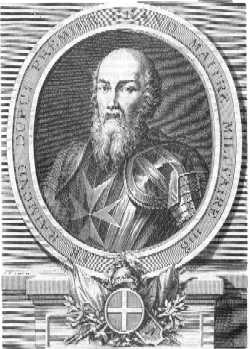
Grandmaster from AD 1125 - 1158

The Hospitallers elected Raymond du Puy as the successor of Blessed Gàrard. It is Raymond's lasting merit to have codified the Order's Rule, which is used here as the main source for elaborating the thesis. The Hospitaller Order was transformed under his direction into a Military Order, following the example of the Knights Templar. Thus it took on military tasks besides the charitable ones. This is no surprise, because many knights were members of the Order already. Providing security to the pilgrims on their way from and to Jerusalem and in the hospitals was a mere consequence of their aim to care for their Lords comprehensively in every respect.


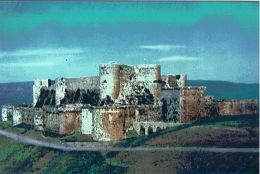
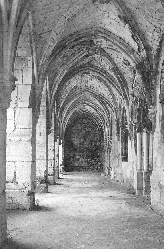
The double role of the Order of St. John as a military and a hospital Order is evident for the first time in a
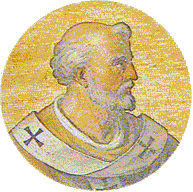
| Innocent bishop, to the reverend
brothers, the Archbishops, Bishops etc. salutation and apostolic blessing.
How pleasing to God and highly revered the Xenodocheum of Jerusalem is,
what pleasant and valuable accommodation it offers to the poor pilgrims,
those have experienced sufficiently, who driven by internal piety, visit
the Holy City Jerusalem and the Sepulchre of the Lord enduring the dangers
at sea and the dangers at land... . There (in the hospital of Jerusalem)
the poor and miserable are being convalesced. The Sick are being
administered a thousand kinds of services of charity. Those who are harmed
by manifold constrains and dangers are getting back there their old vigour
and in order to enable them to visit the places, which were sanctified by
the life of our Lord Jesus Christ on earth, the brethren of this house
always prepared to risk their life for their brothers (the pilgrims)
undertake to protect the pilgrims from the attacks of the infidels on
their way to and fro through squires and animals used for riding which are
very specially selected for this purpose... . These are the people who God
uses to cleanse the Oriental Church from the dirt of the infidels and to
fight the enemies of the Christian name. Because their own funds are not
sufficient for a work so pious and pleasing to God, we appeal by means of
this bull to your charity, that you may remedy the need of those by means
of your abundance and emphatically urge the flock entrusted to you , to
join their Brotherhood and to undertake collections for the upkeep of the
pilgrims and the needy, which results at the same time in the forgiveness
of sins... . To increase their (the brothers commissioned to raise funds)
income we order you, that you make known this statute to your parishioners
by special letters; we further prescribe, that, if some of your clergy
want to serve the brethren of the named hospital with the permission of
their spiritual superior willingly and voluntarily for a period of one or
two years, that they must not be prevented to do so and they must not
forfeit their feoffs and income.
Given at Chalons on this 20th day of February, in the eighth Indiction, in the first year of the pontificate of Pope Innocent II. |
The Pope's appeal to join the Brotherhood does not refer to the order itself or to the Brotherhood of St. John which the order evolved from, but a new institute, similar to the contemporary Third Order of St. Francis or the Benedictine Oblates. This Brotherhood is a confraternity of all who want to support the Order through their prayers and financial offerings. Shortly after his election to the Grand Magistry Raymond du Puy writes about AD 1121 to the bishops and Prelates about this Brotherhood: "As I have become the Servant of the Poor of Christ after the death of Lord Gàrard", he asks to continue their almsgiving, "that they might participate in the benefits and prayers, which originate in Jerusalem ... but those who joined our Brotherhood or who will join it in future, are as certain of God's mercy as if they fought themselves in Jerusalem. They will receive the crown of justification."
Pope Innocent II. confirmed in AD 1135 the privileges granted to the Order by his predecessors.
On 7 February 1137 Innocent II. encourages the Master of the Hospital Raymond for his tasks, puts the Order under his protection and grants it further privileges.
About AD 1140 Innocent II. made an appeal to the whole Church, to support the Order in its tasks.
King (an English historian of the Order) reports that "long before the death of Raymond du Puy, the Knights of the Hospital had become firmly established in England, and Shingay in Cambridgeshire is said to have been granted to them in 1140... . During the middle of the twelfth century ... the gift of land at Clerkenwell was made on which the great Priory was built, the headquarters of the Order in England."
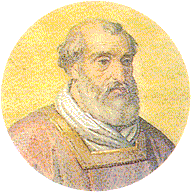
who granted the Order in his bull "Christianae fidei religio" the right to admit priests and to be totally independent from the episcopal jurisdiction, i.e. the Order was ever since directly subject to the Pope.
Thus the members of the Order started to be divided into three classes, the Priests, the Knights and the "Serving Brothers".
In AD 1154 the first German community of the Order is documented to be in Duisburg, in AD 1156 the first community in Austria in Mailberg. AD 1159 follows the first community in Bohemia (now Czech Republic) in Prague. AD 1160 the Order is donated the church and estate at Werben an der Elbe in Germany, which became the motherhouse for the Balliwick of Brandenburg. Between 1158 and 1177 the Order came to Antworskov in Dacia (now Romania). At the same time the communities of Esztergom (Hungary) and Poznan (Poland) are mentioned.
When Raymond du Puy died in AD 1160, he was over eighty years of age.
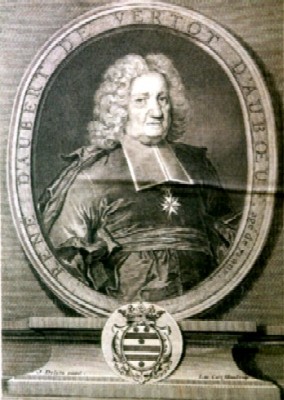
who sings his praises stating that "the Hospitallers and indeed all the Latin Christians of the East, who had been witnesses of his virtues, anticipating his canonisation, revered him as of the number of the Blessed, a title which posterity confirmed to him."
